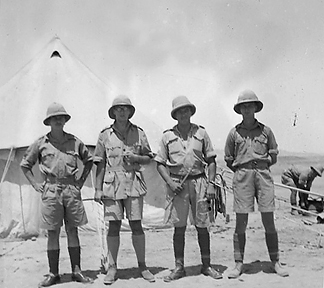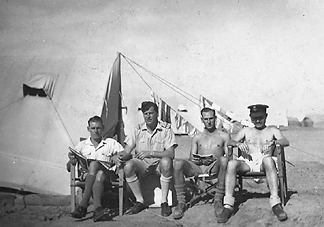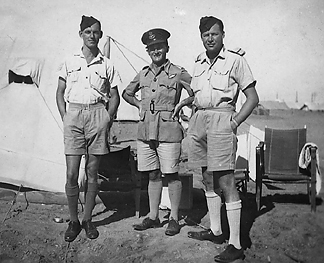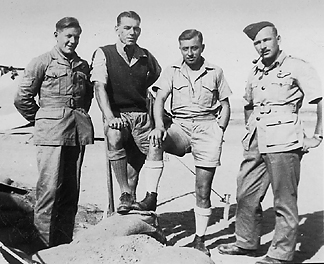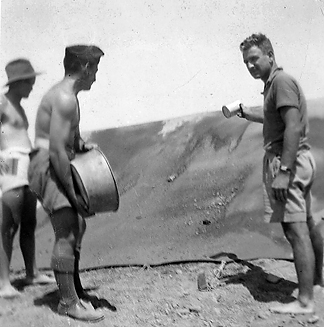|
Sgt JB Keeping WOp/AG 404295 RAAF: KIA 10 February 1942
Rob Keeping’s father carefully kept what memorabilia there was about his brother (and Rob’s Uncle) John. The Keeping boys grew up in Brisbane but the family later moved to Mosman on Sydney’s North Shore.
Rob, too, lives in the Northern Beaches area of Sydney. He and his sister Jennifer were keen to find out more about their Uncle’s RAAF and RAF service. In the course of time, they collected most of the official story and with great generosity and kindness made the whole of their collection available for use here, including a fine collection of photographs.
Apart from the private papers held by the Keeping family, John Keeping’s official records are to be found in the Australian Archives: his personnel record (Series A9301 Item 404295) and his casualty file (Series A705/15 Item 163/132/150). His crewmate George Ritchie’s casualty file is also held there, and is available in digitised form on-line through Record Search (Series A705/15 Item 163/55/168).
Personal background
John Blane Keeping, son of Stephen William and Helen Agnes Keeping latterly of Mosman, New South Wales, had not turned 21 when he enrolled in the RAAF Reserve on 12 April 1940 in Brisbane. 3 months later he enlisted in the RAAF.
Having left Sherwood State School at the age of 15, by 1940 John had served 4 years as a reservist, and was a Lance Sergeant in the AASC. With some determination, he had undertaken Book-keeping and Accountancy studies in 1935 and had already advanced from shop assistant to what we would now know as a Commercial Traveller, working for Slade Allan & co, indent merchants.
Posted to 2 ITS Bradfield Park, Sydney in New South Wales, John Keeping undertook his training as a Wireless Operator Air Gunner (WOp/AG), entering No 4 Wireless Air Gunners Course at 1 WAGS Ballarat and on to 1 BAGS Evans Head.
Promoted to Sergeant on completing the nominally 36 week Air Gunners curriculum under the Empire Air Training Scheme, by late March 1941 he was at 2 Embarkation Depot, Bradfield Park awaiting posting to the Middle East. He embarked at Sydney 9 April 1941 for overseas service via 2 ED, arriving in Egypt on 5 May 1941.
At 70 OTU and to 211 Squadron
Posted to Khartoum and later to Gil Gil in Kenya for his 70 OTU “polishing”, John completed the Blenheim Operations Course from 23 September 1941 through to 22 November, transferring (via the usual route through ME Pool) to 211 Squadron on 28 December 1941. On New Year’s Day 1942 John began keeping a quite detailed diary, which he wrote up every day until the end.
Initially (12 January) he and his crewmates Bev West & George Ritchie were allocated Blenheim IV Z9829 but were re-assigned to Z7699 on 21 January. Leaving Helwan on 28 January in the second flight of three 211 Squadron aircraft departing that day, they completed the 6,500 mile ferry flight in stages to arrive at Palembang P1 on 4 February.
There Z7643, the aircraft of Flight Commander S/Ldr Ken Dundas DFC (with Greece veterans Riddle and Chignall his crew) became unserviceable on take-off. Dundas there-upon took over Z7699, taking Ritchie and Keeping as his crew, to reach P2 on 5 February. Bev West remained at Pakenbaroe with Riddle and Chignall to arrange the repair of Z7643.
Operating thereafter from P2 in Z7699 with Dundas (Pilot) and Ritchie (Observer), John Blane Keeping was lost in action at the age of 22, the crew taking part in the 10 February 1942 raid on Kluang in Malaya described by Bill Baird, and as reported in the RAAF DPS Casualty Section reports.
For long, the family had no final news on his status, other than a missing in action advice from the Department of Air, received in one of the most difficult periods of the war. His family was at last able to finalise his estate following the May 1946 RAAF advice of the RAF official presumption of his death. With some mistakes along the way, painstaking field and office work in the RAF and RAAF pieced together what could be known of their story.
In March 1947, RAAF Overseas HQ at last reported to the Air Board the 1945 discovery by No 1 Search Party (whose grim task had been to record and recover war graves) of the identifiable wreckage of Z7699 in Mankibol Rubber Estate, near Kluang (60 miles north of Singapore). Close by lay the remains of George Ritchie and John Keeping in a grave marked by the Japanese. Subsequently the boys were laid to rest in the Singapore War Cemetery at Kranji. Sadly, the body of Squadron Leader Kenelm CVD Dundas DFC was not recoverable. By one of those equally sad muddles of war, in Canada Ken Dundas’ family had been advised of this discovery by the UK Air Ministry in November 1945.
Australian photographs
To Mum from John with love (Keeping collection)
[RAAF WOp/AG recruits for No 4 Course 1 WAGS Ballarat: at Bradfield Park late 1940]
John Keeping captioned his photos and in ink too, but his fine, fast handwriting was even harder to read, once partly water damaged. Interpreted by Rob and by me, the list seemed to be (from L to R, front to rear as usual, with later annotations in square brackets):
Ray William Qld; Nev Purvis Qld; Dave Andrews Vic; Barry Brown Vic; Cliff Briggs Qld; Bob Ash SA; Keith McKay Vic;
Robby [Robinson] NSW; Ken Gardener Qld; ?[WG] Gaston WA [S/Ldr WG Gaston]; John McNeill Vic; Wally McKeachin WA [406099 F/Lt WJ McKerracher DFM lost in a 45 Squadron Mosquito accident 13 May 1945]; Colin Cubitt Tas; Fred Gildie NSW [402288 Sgt FS Gildea, missing 7 May 1941, No 1 Squadron Hudson A16-25 over Johore Straits]; Ron Clark Qld; Blue Thompson Vic; X QUEENSLAND [ie JBK]; Allen Tillot NSW; Doug Frith SA; Vic Simmler Vic; K Eckersley Qld [KIA 9 April 1942, 11 Squadron RAF]; A Fuller Vic; Allen Morton SA; T Holdgate Vic.
[The Australian States: New South Wales (NSW), Victoria (Vic), Queensland (Qld), South Australia (SA), Western Australia (WA) and Tasmania (Tas)]
“X” standing there 8th from the right (or 9 from the left) in the back row is JB Keeping, 6 foot of proud Queenslander. The nominal rolls of the RAAF personnel section offer some brief record men with some relationship to 211 Squadron.
From the outset, this undated group of 24 Aussies looked as though they might be fresh to the RAAF: most in overalls (some with collar and tie beneath), one at least in shirt sleeves and shorts, and many with the favoured Akubra head gear. Certainly RAAF personnel, this big group seemed likely to be an enlistment or course entry shot in Australia - the hats have that newish Akubra look about them.
And so it turned out to be, thanks to correspondence between Adrian Fryatt and Dr WG Gaston, who is in shot, standing third from the left. 406097 Walter Garfield Gaston remustered as a Navigator and left the RAAF in January 1946 Squadron Leader of 52 Squadron. Gar Gaston was also able to correct the entry for McKerracher, who was unfortunate enough to be lost in that period of structural failures that some Mosquito units encountered in the tropics (and which ultimately saw 211 Squadron disband in 1946). In other correspondence with Adrian Fryatt, Doug Frith was also able to add Robinson’s name and the death of Eckersley (lost in the 11 Squadron action against the Japanese fleet off Ceylon 9 April 1942, also referred to by Les Payne). Doug, however, recalls the photo as taken at Bradfield Park in Sydney, home of 2 Embarkation Depot and 2 ITS.
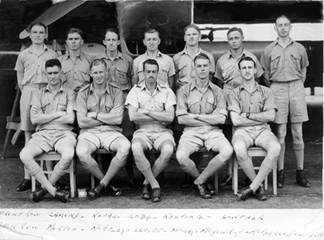 |
[1 BAGS Evans Head: 4 Course WOp/AG graduates March 1941] (Keeping collection)
RAAF personnel in another undated but clearly official group shot from the Keeping collection. Three of these men were later members of 211 Squadron, and were killed in action in the Far East, shown thus.
Front row: Lamond (KIA 6 February 1942), Kevan, Lobb, Keeping (KIA 10 February 1942), Lother
Back Row: Morton, McAuley, Levitt, McKay, McDonald (KIA 21 February 1942), McPherson and Lindschau.
Kevan was later to serve with in Blenheims with 113 Squadron over Burma and was lost in action on 18 June 1942.
The aircraft is an apparently hangared Fairey Battle in trainer yellow. Some 360-odd Battles came to Australia for EATS use from April 1940 onwards. Clad in standard yellow overall, they were mainly used at RAAF Bombing and Air Gunnery Schools. Up to December 1941 these were 1 BAGS at Evans Head on the far North Coast of New South Wales and 2 BAGS at Port Pirie on the Spencer Gulf in South Australia’s mid-North.
John Keeping completed his course at 1 BAGS from early February to early March 1941. In March and April he was at 2 Embarkation Depot Ascot Vale (Melbourne) awaiting embarkation for the Middle East. Lamond, Keeping and McDonald were all WOp/AGs, so this shot, too, looked likely to be a course photo.
And so, too, it turned out. For some time, I’ve enjoyed an amiable correspondence with David Vincent in Adelaide, whose main work is his astonishingly rich RAAF Hudson Story. In the course of his continuing research, David has gathered much material. Among that treasure is the Graduation Dinner menu of No 1 WAGS Ballarat No 4 Course, dated 3 February 1941. This he received long ago from one of the participants, Bob Hart.
The Ballarat menu matches with 9 of Keeping’s undated shot of 12 seated before a Battle, indicating that they were all WOp/AGs of No. 4 Course who trained at 1 BAGS Evans Head in early 1941. Not only that: as well as the customary autographs, the Course menu (below) included a list of course graduates. The listed personnel match closely with John Keeping’s earlier photo: perhaps as many as 16 of the 58 No 4 Course graduates (all but three of these very confidently) are present among the group of 24 cheery ruffians in overalls. So, thanks to Gar Gaston and Dave Vincent, once again the mist of history lifts a little.
RAAF Graduation Dinner No 1 Wireless Air Gunners School Ballarat
No 4 Course, Empire Air Scheme, 3 February 1941 (D Vincent collection)
|
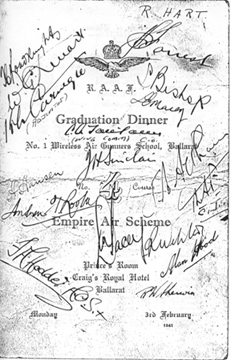
|
|
Graduates
|
|
|
LAC Andrew DT
|
LAC McKay ND
|
LAC Tillott AA
|
|
Ash RCA
|
McNeill JJ
|
Tredenick AF
|
|
Briggs CG
|
Paton JA
|
Thompson WJH
|
|
Chenoweth CO
|
Pleitner WE
|
Watson LT
|
|
Clark RI
|
Purves LL
|
Cullen DR
|
|
Cubbitt CL
|
Levitt F
|
Farrer JM
|
|
Donald GR
|
Lobb JH
|
Wohlers JE
|
|
Frith D
|
McAuley LE
|
Bennett JFM
|
|
Gardiner KA
|
Muller RC
|
Benn RE
|
|
Gildea, FS
|
Pitman AJ
|
Brinkley JL
|
|
Guthrie KC
|
Stephens HR
|
Catchlove G
|
|
Hart RR
|
Wilson RH
|
Clarke EG
|
|
Hensel ER
|
Lindschau GA
|
Davis AW
|
|
Hedges GJ
|
Quayle LH
|
Eckersley GK
|
|
Jones WM
|
Reid JR
|
Gerloff CM
|
|
Julien PH
|
Robinson LN
|
Gillan JW
|
|
Keeping JB
|
Seidel RA
|
Jansen RF
|
|
Malcolm AWP
|
Semler BH
|
Jacobsen EW
|
|
Morey LG
|
Stokes CJR
|
Lamond HJ
|
|
McDonald MD
|
|
Overseas Photographs
Unlikely to be Kenya or Khartoum, from John’s service record and the other personnel present it seems most likely that these shots are from the period at Helwan with 211 Squadron, from late December 1941 to late January 1942. John remarked on “having some snaps taken” on January 20 - perhaps they were these.
In the desert: an unknown group (Keeping collection)
Left to right: Self, Bev [West] Don Chalmers (Pommy) Bill Wicke (SA)
Some of the boys (Keeping collection)
Wicke may perhaps be 407476 Donald William Wickes of South Australia, who was certainly in Egypt for a period in late 1941. F/Lt Wickes was reported missing on a Mediterranean reconnaissance flight in April 1944.
Left to right: self, George Ritchie (Vic, Navigator), Bev West (SA, Pilot)
The crew: and what a crew. (Keeping collection)
Unknown group. 2nd left is JB Keeping (Keeping collection)
The boys at work: which is very strange (Keeping collection)
The diary of 404295 Keeping JB Sgt WOp/AG RAAF
From his photos, John Blane Keeping was a tall, serious young man, and his service record (in his own hand) shows his steady approach to life. Arriving in Egypt, John set about getting organised, soon finding himself a good diary. He chose The Scribe 1942 Desk Diary produced by Etablissement Scribe Egyptien. With its generous octavo page a day and packed with details of currency, measures, eclipses, time differences, Egyptian and other holidays and so on, it had all the little aids he liked to use as a carefully organised young man: extra memorandum pages, petty cash rules on each page, and the like.
Having put his name and number on the fly leaf, he carefully marked 20 February on the opening 1942 calendar, then turned to the rear Telephone Numbers pages to record the addresses or phone numbers of numerous friends, family and service mates (either RAAF boys or QX and VX diggers of the 2nd AIF). In his neat, fast hand, he reserved the largest flourish for an entry on the last page, for someone whose address he had no need to record: Miss Gretta Rodda. All he needed to write for Gretta was her phone number, in Brisbane’s suburban Ascot. Turning to the page for the 20th of February, John made another neat entry: “Gretta's birthday”. A little later, he returned to this page to add “many happy returns always”.
Each day he wrote brief details of his daily doings, a habit clearly already well established and perhaps born of his industrious progress in the commercial world. Every day he made his careful summary: letters received or sent (his and Gretta's frequent letters to each other prominent among them); the daily routine of work and leisure; petty monies; and very occasionally a little laconic gossip—more an aide-memoire than an eye to posterity. His opening entry is typical:
January 1942
“Thursday 1 Commemoration Day (Australia)
At midnight I celebrated New Year’s Eve in the Helwan train with Tom McInerney, arrived home at 0145. Parcel arrived from Mum. Very bleak day and how.
Had a very quiet day. At night had a few drinks and then went to the [RAF] Station theatre and saw They Made Her A Spy. Very good show.”
[Over the next three weeks the pace in the tented camp at Helwan was very slow, mostly devoted to gathering personal kit and equipment on Station or with quick trips into Cairo. A leisurely period like this would have been called “tidy days” in the Navy. John noted the departure of the Squadron’s Ground Party by train on the 16th. Then on 21 January, Bev West brought Z7699 (the Blenheim Mark IV now allotted to Bev West, George Ritchie and JBK) back from Abu Sueir. Thereafter John was at work on the aircraft every day: on either his radio, the intercom or the guns.]
“Thursday 22
On this particular day we were detailed to our kites. I went down and looked them over. Nothing much was wrong.
Friday 23
Rose very early and caught a truck into Cairo after which I went into El Maza by Car and picked up my Irvine Suit. On returning to Cairo I had lunch with Mal and came home [ie returned to his tent].
Saturday 24
Rose at 0800 and at 0900 went to the kite. Played around all day and was very tired at night.
Sunday 25
Rose at 0800 and at 0900 I went down to the kite. After working on her until lunch time, I had fixed the W/T [the radio transmitter receiver]. After lunch I went down again and played around. At night I drank until 0200. Good night.
Monday 26 Australia Day
At 0900 I went down to 7699 and tried to harmonize my guns [the twin machine guns in the rear turret]. After spending all my time it was lunch time. Mal and I went to Main Camp Mess after which we returned and spent the rest of the day [sic: at the aircraft, presumably]. Some mail arrived from Gretta and George. At night Mal and I went to the pictures.
Tuesday 27
Rose at 0700. After having breakfast a truck called for us and our flight [The crews of West, Harrison and Paterson] went into AHQ to be briefed. After briefing Mal and I had lunch and went around to AIF canteen and purchased some things after which we came back to Helwan and went straight to our kite. After harmonizing my guns, checking my ammo and TR9 it was time for dinner. After dinner I wrote.
Wednesday 28
[From this date on, the daily entries are more descriptive and in pencil, pens being unreliable aloft.]
Airborne. Rose at 0700. After a wash and clean up had breakfast. We were at the kites at 0900 and at 0915 had started up. At 0935 we took off from Helwan, leading the second formation [ie the second Flight of three aircraft]. It was rather hazy. We flew at about 2,000ft and went past Ismailia, then straight up the Med coast to Tel Aviv and then went inland to Lida [Lydda, probably]. From then on across the mountains it was rather bumpy, it was still very hazy, the country was just waste. At 1249 we landed at Habbaniya. My, what services, it is the best RAF station I have been to, after an excellent five course meal I had a bath and went to bed.
Thursday 29
Airborne. We rose at 0500. I did not sleep very well, lousy bed. After breakfast a bus called for us and at 0437 GMT we left. After flying down past Basra and along the Persian Gulf we arrived at Bahrein to refuel. Here Bev, George and I had some lunch. Turned [out] this place is just an island with a bridge joining it to the mainland. Nothing but sand. At 0959 GMT we took off and flew for 2:45 [hrs] over the southern portion of the Persian Gulf and landed at Sharjah [near modern Dubai in the Gulf States], an outpost in the desert very close to the coast, BOAC. It was just like a fort with the landing ground outside. Anyway its a good spot, nice rooms and meals. I slept like a top.
Friday 30
Airborne. Rose at 0500 and after having an excellent breakfast went out to the kite, it was rather cold but after pushing the kites out I was very hot. We left Sharjah at 0306 GMT, the sun was just rising and there was a slight ground haze. The country we flew over was very desolate. After about 40 minutes we reached the coast [of Iran, Gulf of Oman] and from then until we reached the Indian coast West of Karachi, about 20 minutes before reaching the BOAC outpost, our I/C [intercom] gave up the ghost. It was wonderful to [note?] the efficiency since we left Egypt. After having a few grogs we were paid, then dinner and to bed.
Saturday 31
Airborne. Rose at 0630 at Karachi and after having an excellent breakfast I went out to the kite. The Flying Fortresses [sic] were warming up. At 0306 GMT we took off and flew due East. There was only one patch of desert, the rest was thickly populated and well irrigated. At 0739 we reached Allahabad and after packing our things decided to go to the Big Smoke. It was a small but nice place but the cripples [street beggars] were terrible. I went to the Bazaar and made a few purchases after which we went back to the hotel and dined and then home to bed.
Memorandum
[The desk diary had one or more Memorandum pages at the end of each month, so that each had an equal number of pages, with the first day of the month always on a right-hand page. For January there was just one such page, which John filled with a small table of personal hints, quite successfully obscure but possibly some sort of personal code for correspondence. Such ruses amused the official censor and families alike, if for different reasons. This page had been completed in ink, apparently before the long ferry flight began].
In action: John
Q Mary: 404295 [his service no]
Q Elizabeth: 404295
Mauritania: 404295
Aquitania: 404295
Strath line [?]: 404295
Emp: 404295
Indian Ocean: Indigo [sic] Jones
Pacific Ocean: Peace and quiet
England: Gretta Mum
Sing[apore]: Gretta Mum
Palis [?]: Gretta Mum
February 1942
Sunday 1
Airborne. We were called at 0630 and after a very short breakfast we pushed off. Dru Paterson was missing after we got into formation but he picked us up at Dum Dum [Calcutta], the trip was very uneventful. [It was Paterson who saw to it that Keeping’s diary reached his family - see his letter, next below]. The country was very thickly populated and half way through we passed very [big?] coal fields. On arriving at Dum Dum we were briefed and instead of pushing straight on we stayed the night. A truck picked us up and took us into the Grand Hotel Calcutta. After a shave and a bath, Mal, Jack and I went for a ride around the town in a rickshaw. It was good fun [only?] costing us six annas. For an hour after dinner George and I went around to the 300 Club and had a very enjoyable evening meeting the [locals???]. At 1200 [midnight, presumably] we got to bed.
Monday 2
Airborne. At 0630 we rose and after having breakfast in bed we took a gharry out to Dum Dum [the RAF station then on the Northern outskirts of Calcutta]. At 0230 GMT we took off. It was a rather misty morning and after we had formated we went over the [dhows?] and then on our [way?]. Of course our guns were ready as we were in the real thing after passing over the basin of the Ganges. We went out over the islands towards the Burmese coast. It was very hilly and thickly forested country. After five hours flying we reached Toungoo [about 180 miles North of Rangoon, by the Sittang R and the railway to Mandalay]. In the mess that night I met some of the boys in 113 [Squadron, based there and also with Blenheim IVs]. I then went to bed.
Tuesday 3
Airborne. At 0530 we rose and after a lousy breakfast went out to our kite. It was very misty and we did not get off until late. Our first hop was very short [!] and after an hour's flying we reached Rangoon. It looked as though it had been bombed as there were a few hangars and kites burnt. After refuelling we made off again, this time a long hop to Kota Radja (Koetaradja). The trip was very pretty, all over the islands [Andaman Is]. Port Blair seemed a very nice place, we flew right over it . On reaching the end of our flip [“flip”: from Rangoon to Sumatra!] we struck some rain squalls and when we did land we were out of juice. The town is Dutch of course and very pretty. We stayed in a very nice pub but nobody could speak English.
Wednesday 4
At 0415 [local?] we were picked up and taken out to the drome and after packing up, we left. Just as we took off our I/C went. I fixed it up and as our last kite took off, a Japanese recco kite was sighted but only for a few minutes. The trip to Pakenbaru [central Sumatra] was very uneventful. We flew over some rather hilly country at first and then came over some very marshy ground. After refuelling we taxied out. Just as we were about to take off the OC of our formation's [S/Ldr Dundas] plane went u/s [unserviceable], and he took over our kite and we [ie Ritchie and Keeping, leaving Best to wait for the repair of the other aircraft] flew with him. On reaching the mouth of the Palembang R [ie the Moesi], we hit a storm and began to circle around. There the rest of the formation left us. At last the storm broke and we arrived at P1 [ie Palembang proper]. After a lot of messing around I got on a truck and reached Palembang. I went around to the Buy's Hotel and who should be arriving there but General Wavell [ie, bad timing. At least John knew who he was!]. Well eventually I got to bed on the verandah of a house. I got no sleep at all. There was an [air raid] alert but after about an hour the All Clear was sounded.
Thursday 5
The next morning I rose from the verandah and after a wash went around to Smits Hotel and saw Mr Dundas S/Ldr. He told me to wait for him so back I went to our house. We eventually went out to the drome at P1. Our kite was having a DI [Daily Inspection] so we did not get away until 1610. It was only a fifteen minute trip to P2 and after a lot of messing around we got some place to sleep. I did not get very much sleep, as [at?] the so-called bar I met the rest of the boys who had gone to Sing [possibly Singapore, rather than a singalong].
Friday 6
This was the first morning for quite some time that I was able to sleep in. I did not rise until 1000. After a wash I went out and started on my guns, my they were dirty. Well after working all day on it I went to bed.
Saturday 7
At 0230 I was awakened and told I was on a raid. Well I was very tired but after a shave and a wash I felt a bit better. At 0330 a truck came for us and took us to Operations Room. After briefing I found out that we were going as escort to a convoy and taking off at 0530 [the clear consistency of these very early times, recorded so soon afterwards, stand in contrast to other reports such as Baird, Bateson]. We took off once and had to land again as our undercarriage would not go up. In ten minutes time we were in the air again heading towards the coast. In a very short time we were there and I sent [the] identification letter, then for three hours we circled the convoy. At least a dozen time we shot it up [ie the fast low passes they so enjoyed] and saw many women and children on the ships. They had come from Sing. [Singapore]. Nothing was sighted and we left at the appointed time. [Bill Baird was scathing of this duty, being pointless against any air attack]. When we arrived back we found a couple of the boys were missing [Steele and Bott, all RAAF crews]. I went to sleep in the afternoon and was awakened again to find I was on another operation but eventually got left out.
Sunday 8
Miss Paterson’s birthday. At 0800 I rose for breakfast after which I went out to the Kite. I spent all day at it.”
[Here John’s diary entries end.]
Narrative of Sgt CAH Paterson 10th March 1942
[Sgt Paterson’s letter was written as the final entry in John Keeping’s diary on the pages for Monday 9 and Tuesday 10 February 1942. In October 1945, this kind, if mistakenly hopeful letter was transcribed by the Keeping family and sent to the RAAF Casualty Section in the hope that it might help in finding out what had happened to John. Here, with access to the original pencil ms, I have made some minor corrections to spelling, and any amplifications [thus]].
“John’s original Crew comprised
P/O Bev West (Pilot) [sic: Flying Officer]
P/O George Ritchie (Observer) (400543) [sic: Flying Officer]
John (WAG)
On the flight out from Egypt the six aircraft of the 4th flight were commanded as follows:
S/Ldr Dundas (Flight Commander) 1st Section
P/O Mackay [sic: Flying Officer]
Sgt. Burrage
P/O West 2nd Section [sic: Flying Officer]
Sgt. Harrison
Sgt. Paterson
[Consistent with the Far East Air Party summary, the last Flight of the 24 aircraft suggested earlier, and with the 1943 account of Squadron CO W/Cdr RN Bateson DFC.]
At Pakanbaroe (Sumatra) [ie Pakenbaru] on the last leg of the journey (see John’s entry 4th Feb) Dundas' machine packed up temporarily and at the last minute he transferred to Bev West's machine, retaining George Ritchie and John as his crew and leaving his own Observer and Gunner behind to follow on with P/O West when the aircraft was repaired.
At Palembang (Sumatra) we were put straight into operations and as Bev West was held up at Pakanbaroe with a further accident and later a ground strafing raid by Jap fighters which further damaged the machine, John was prevented from rejoining his pilot and carried on with S/Ldr Dundas who became our A Flight Commander at Palembang and who was one of the finest officers I have ever known.
On this date [ie the night of 9/10 February] we were detailed for a night raid to Kluang, an aerodrome in Jap hands about 60 miles north of Singapore. 211 Squadron crews were:
W/Cdr Bateson (CO)
S/Ldr Dundas
my own [ie Paterson’s]
P/O Chalmers
Sgt Manton
Take off was set down for approx. 01.40hrs on this day (10th). There was delay and some confusion and the two later crews failed to take off. Chalmers bogged and Manton taxied into an obstruction in the darkness. We reached our objective and bombed the aerodrome. We ran into searchlights, anti-aircraft fire and night fighters, but none of them appeared very effective. John failed to return and we have no knowledge of what might have happened to them. Dundas was a capable and experienced pilot, and as the opposition was not severe [but see Bill Baird’s narrative - the later arrivals found the defences more aggressive], I can only put their disappearance down to the sheerest bad luck.
John was a good fellow and those of us who are left sincerely regret the loss of a pal. We had such faith in S/Ldr Dundas that we cannot believe that they are definitely gone. We feel that through some accident they were forced to bail out over enemy occupied territory and they have probably fallen into enemy hands.
We were forced to evacuate Sumatra on 16th Feb. and later were sent out of Java on 27th February.
Written in Ceylon 10th March, 1942.
Sgd. Druo. CH Paterson Sgt.”
[The accuracy and detail of Paterson’s summary was both useful and tantalising. The closing dates indicated that he was very probably evacuated to Ceylon aboard the crowded Kota Gede. The content of the letter suggested, although without certainty, that Paterson, a pilot, was an RAAF man. His use of an abbreviation and initials was open to misinterpretation and indeed no clear match to a DCH Paterson could be spotted among either RAF or RAAF rolls or other sources
For some reason, a sensible meaning for either “Dru” (Keeping) or “Druo” (Paterson) eluded me until this 2016 update, when a check for any RAAF pilot named Paterson with Andrew as at least one forename produced immediate results.
From the World War II Nominal Roll and confirmed by his RAAF personal file, now digitised in the National Archives of Australia, he proved to be one Charles Andrew Hamilton Paterson 404514, of Brisbane. His signature in Keeping’s diary matches those on official forms (which also illustrate the order he liked to use for his family names).]
Commemorated
John Keeping is commemorated on the Australian War Memorial Honour Roll and by the Commonwealth War Graves Commission on the Singapore memorial and in the Kranji War Cemetery, where his remains lie with those of his crewmate George Ritchie. His CWGC entry:
In Memory of
JOHN BLANE KEEPING
Sergeant 404295
Royal Australian Air Force
who died on Tuesday 10 February 1942
Age 22
Son of Stephen William and Helen Agnes Keeping, of Mosman, New South Wales, Australia.
Joint grave 29 E 17-18
Kranji War Cemetery
Remembered with honour
Gretta never got the birthday greetings he would have sent her in Ascot. Perhaps today she remembers him still.
Sources
JB Keeping Diary and photographs (Keeping family correspondence with author)
RAAF Personal file 404295 Keeping (NAA A9300/Keeping)
RAAF Casualty file 404295 Keeping (NAA A705/15 163/132/150)
RAAF Casualty file 400543 Ritchie (NAA A705/15 Item 163/55/168)
Air Ministry Index to Airmen and Airwomen TNA AIR 78/123
Gaston G correspondence via A Fryatt
Vincent D correspondence with author
Jane’s All the World’s Aircraft 1941
KNILM Complete Map of the Airlines of KNILM, Royal Netherlands Indies Airways c 1935
KNILM The Intercontinental Air Express (monthly issues 1938 to 1942)
War Office General Staff Geographical Section reprints
Sumatra 1:250,000 Koetaradja Sheet 1 [NLA MAP G8080 s250]
Overzichtskaart van Sumatra 1:750,000 Sumatra Blad I (1936) [NLA MAP G8080 s750]
www.211squadron.org © D Clark & others 1998—2025
Site created 15 Apr 2001, last updated 24 Dec 2025. Page created 2 Mar 2002, last updated 31 Jul 2021
Home | Site Summary | Next | Previous | Enquiries | Glossary | Sources | Site links | Do it yourself | Site updates | Site Search
|





